biochemical and haematological profile - Universitatea de Ştiinţe ...
biochemical and haematological profile - Universitatea de Ştiinţe ...
biochemical and haematological profile - Universitatea de Ştiinţe ...
Create successful ePaper yourself
Turn your PDF publications into a flip-book with our unique Google optimized e-Paper software.
<strong>Universitatea</strong> <strong>de</strong> Științe Agricole și Medicină Veterinară Iași<br />
found in calves in this study is close to that obtained from De la Fuente et al. (1998b) in<br />
Central Spain (52.3%) which also ma<strong>de</strong> epi<strong>de</strong>miological investigations in young cattle in the<br />
first month of life. Similarly, in Germany, Otto et al. (1995), found in calves, in the first three<br />
weeks of life, a prevalence of Cryptosporidium infection of 52.5%.<br />
Table 2<br />
Prevalence of infection with enteropathogens in calves in the first months of life in<br />
investigated areas of Romania<br />
Infection(s) with Positive samples (%) (n=370)<br />
Cryptosporidium alone 103 (27.8)<br />
Rotavirus alone 31 (8.4)<br />
Coronavirus alone 7 (1.9)<br />
E. coli F5 (K99) alone 1 (0.3)<br />
Cryptosporidium + Coronavirus 22 (5.9)<br />
Cryptosporidium + Rotavirus 20 (5.4)<br />
Cryptosporidium +E. coli F5 (K99 2 (0.5)<br />
Coronavirus + Rotavirus 3 (0.8)<br />
Cryptosporidium + Rotavirus + Coronavirus 5 (1.3)<br />
Cryptosporidium + Rotavirus + Coronavirus<br />
1 (0.3)<br />
+E. coli F5 (K99)<br />
Total 195 (52.7)<br />
Legend: n = number of animals investigated<br />
The second enteropathogen agent, as prevalence (16.2%), was rotavirus. It is however less<br />
prevalent than reported by other authors in Israel (41.4%), Spain (42.7%), Irel<strong>and</strong> (38.9%) (6,<br />
15, 16). Values close to those reported by us were reported by Abraham et al. (1992) in<br />
Ethiopia (16.7%), Garcia et al. (2000) in Spain (20.4%) <strong>and</strong> Pérez et al (1997) in Costa Rica (7%).<br />
Coronavirus infection prevalence in calves (10.3%) found in the investigated areas are<br />
comparable to that found by Akam et al. (2004) in Algeria (7.5%).<br />
Lower prevalence of E. coli F5 (K99) infection found in our study may be a consequence of<br />
reduced sensitivity of tetravalent ELISA‐kit, fact reported in a paper by <strong>de</strong> Fuente et al.<br />
(1998a).<br />
Mixed infections were found in 14.3% of the investigated calves. The most common<br />
association observed was between Cryptosporidium <strong>and</strong> coronaviruses (5.9%) followed by<br />
Cryptosporidium – coronavirus association (5.4%). This fact is in contradiction with the results<br />
published in the majority of studies worldwi<strong>de</strong>, who sustained that the most common mixed<br />
infection is with Cryptosporidium <strong>and</strong> rotaviruses (6, 13, 16, 20).<br />
The four pathogen agents i<strong>de</strong>ntified by ELISA, evoluated as unique infections <strong>and</strong> lass as<br />
associated infections. This may suggest a competition between different enteropathogen<br />
agents for the same biotope.<br />
CONCLUSIONS<br />
� The epi<strong>de</strong>miological screening carried out using ELISA double‐s<strong>and</strong>wich technique at<br />
young calves, in the first month of life, from Western, Central <strong>and</strong> North‐Western Romania<br />
revealed a prevalence of 41.4% for cryptosporidiosis, 10.3 for coronavirosis, 16.2% for<br />
rotavirosis <strong>and</strong> 1.08% for enterotoxigen E. coli F5 infection.<br />
46


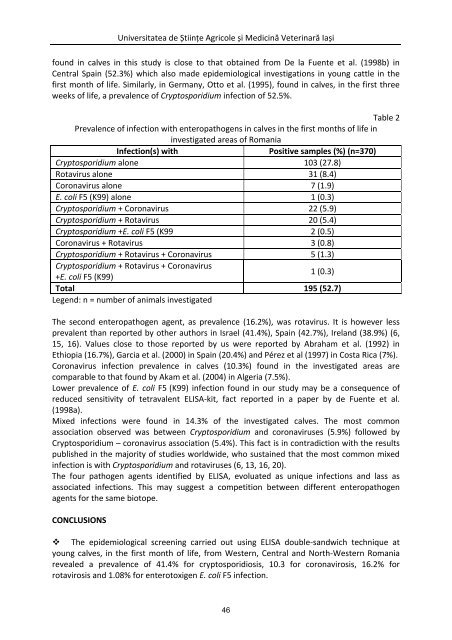
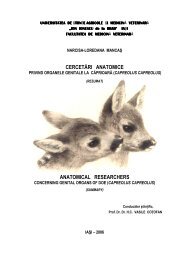
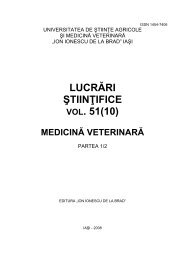
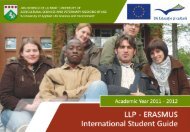
![rezumat teză [RO]](https://img.yumpu.com/19764796/1/190x245/rezumat-teza-ro.jpg?quality=85)
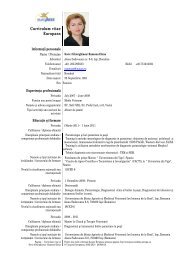



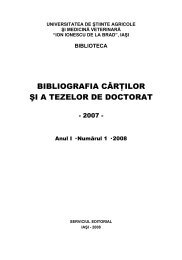
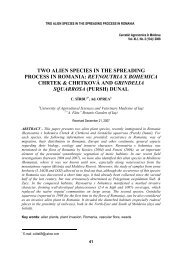
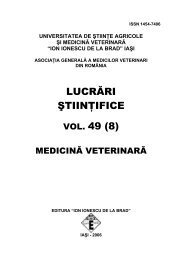
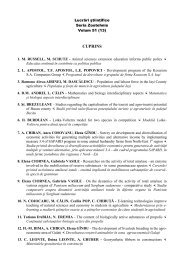
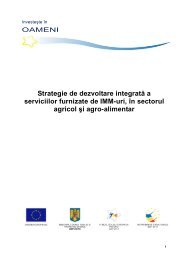
![rezumat teză [RO] - Ion Ionescu de la Brad](https://img.yumpu.com/14613555/1/184x260/rezumat-teza-ro-ion-ionescu-de-la-brad.jpg?quality=85)
